In the evolving world of commercial landscape design, one principle is rising to the forefront: people matter most. The modern landscape is not just about aesthetics or environmental performance—it’s about human experience. In British Columbia and beyond, businesses, institutions, and public spaces are embracing people-centric design as a core value. They recognize that when outdoor environments prioritize human comfort, well-being, and inclusion, they become more than green spaces—they become destinations.
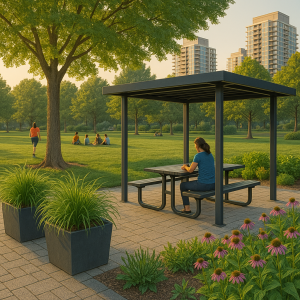
Designing for Human Experience
Human-centred landscape design creates spaces that invite interaction, reduce stress, and foster connection. Increasingly, across various settings—from office campuses to retail developments—this shift in principles shapes how designers structure outdoor areas with an eye toward usability, accessibility, and emotional impact.
Specifically, in British Columbia—a region known for its natural beauty and active outdoor culture—designers merge this philosophy with the local environment. As a result, commercial spaces now reflect both ecological balance and human comfort. Designers incorporate shaded seating areas using native trees or smart pergolas, build wide accessible pathways, and arrange vibrant sensory gardens to serve people first.

Key Elements of People-First Design
Comfortable and Inclusive Seating
Designers integrate benches, picnic areas, and flexible seating pods into commercial landscapes with thoughtful intention. Notably, they include features like armrests, varied seat heights, and shaded placement to encourage users of all ages and abilities to relax and stay longer.
Accessible Pathways and Navigation
Barrier-free walkways, tactile paving, and intuitive spatial layouts promote accessibility and ease of movement. Consequently, these features help visitors with mobility challenges move freely and use the space equitably.
Sensory and Healing Gardens
These gardens engage the senses and support mental wellness through fragrant plants, textured pathways, and calming water features. Today, hospitals, senior facilities, and wellness-focused office parks across BC increasingly add these elements to their outdoor environments.
Interactive Spaces and Social Nodes
People gather where design invites them to. Landscapes that include amphitheatres, café patios, or central greens help communities connect. Furthermore, these spaces support events, performances, and informal meetings, enhancing the location’s vibrancy.
Climate-Sensitive Features
Given British Columbia’s diverse climate zones, designers often integrate covered walkways, windbreaks, and rain gardens into their projects. In doing so, they keep the landscape functional and comfortable throughout all seasons while maintaining ecological value.
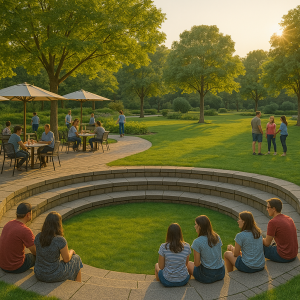
Sustainability as a Human Concern
Sustainable design goes beyond conserving resources—it secures long-term well-being for people who use the space. Drought-tolerant plantings, green roofs, and bioswales manage stormwater and offer aesthetic and experiential benefits.
For instance, IslandEarth Landscape Company, a leader in sustainable commercial landscaping in British Columbia, integrates bioswales and permeable paving into its designs. Through this approach, the company reduces the environmental footprint and improves the user experience. Its projects clearly show how eco-friendly infrastructure enhances the daily lives of people who work in or visit commercial properties.
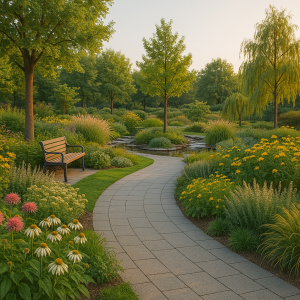
Why Prioritizing People Matters
Research supports what intuitive design already suggests: outdoor spaces that meet human needs improve mood, boost productivity, and promote community interaction. In commercial settings, this means businesses can expect happier tenants, more loyal customers, and better employee retention.
To illustrate, offices that include outdoor breakout spaces report higher staff satisfaction. Retail centers that offer comfortable seating and garden features see visitors stay longer. Public plazas that provide shade, art, and accessibility attract a wider demographic and foster inclusivity and social equity.
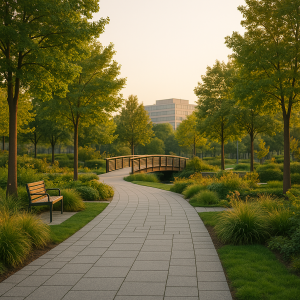
Current Trends in Human-Centric Landscape Design
British Columbia’s commercial landscaping industry is embracing several trends that reflect this human-first mindset:
-
Biophilic Design: Designers integrate natural patterns, materials, and forms into built environments to foster a deeper human-nature connection.
-
Wellness Integration: Projects now include outdoor fitness areas, meditation nooks, and edible gardens to support holistic wellness initiatives.
-
Technology and Smart Design: Motion-sensor lighting, Wi-Fi zones, and app-controlled water features improve functionality and make spaces more responsive to human use.
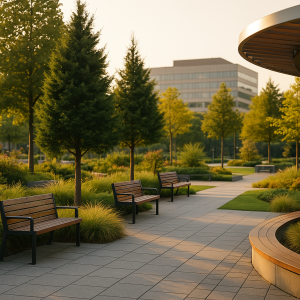
Designing with Intention
Commercial landscapes serve as more than just green embellishments—they extend the human experience. By focusing on comfort, accessibility, social engagement, and sustainability, landscape designers elevate everyday life.
Ultimately, in British Columbia—where community, ecology, and innovation intersect—IslandEarth Landscape sets the standard for what people-first design can achieve. As this movement grows, more commercial properties will embrace the human element, resulting in landscapes that are not only seen—but truly felt.